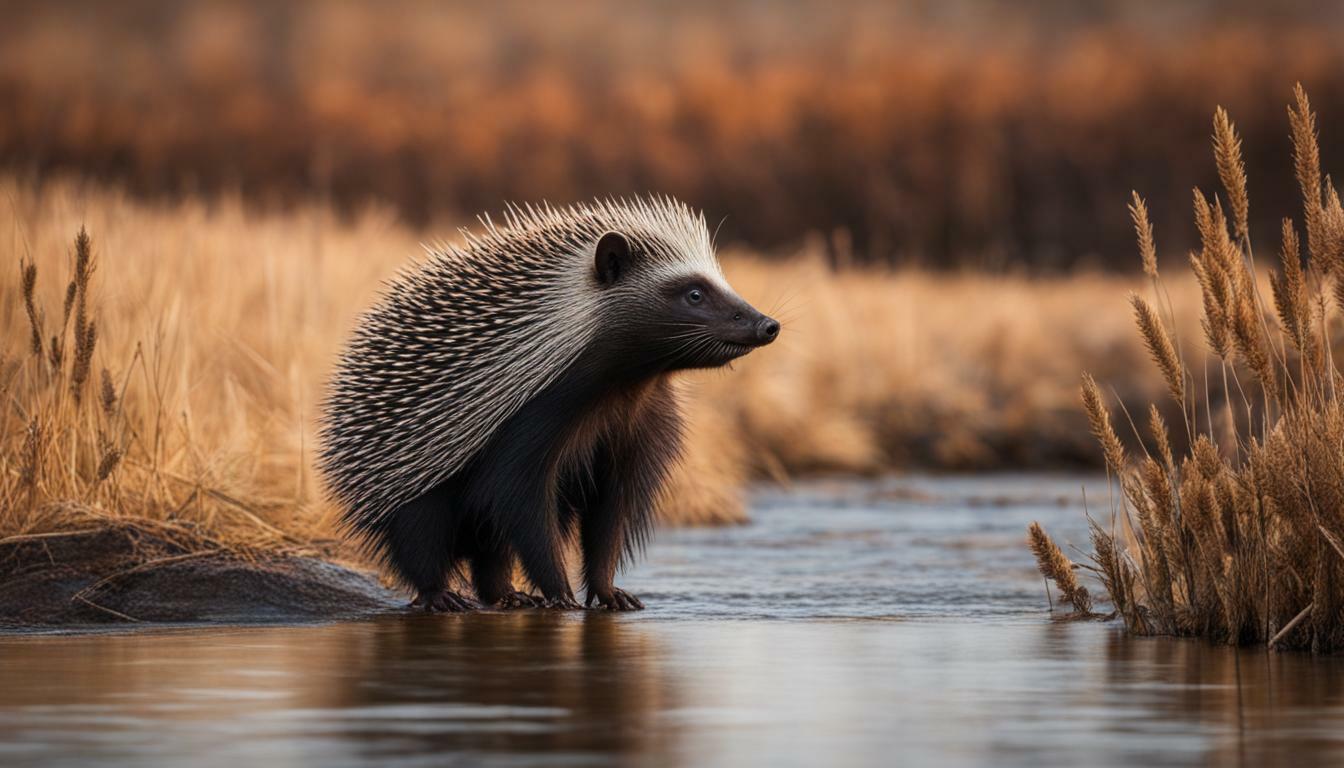Iowa is home to a diverse range of wildlife, but are porcupines among the native animals that can be found in the state? Let’s explore the presence of porcupines in Iowa and discover whether these fascinating creatures can be spotted here.
Key Takeaways:
- Porcupines were once common in Iowa but their population declined drastically from the mid-1800s to the early 1900s.
- Nowadays, porcupines are rarely seen in Iowa and are more commonly found in the forests of neighboring states to the north and west.
- A recent sighting of a porcupine in Sioux City, Iowa, created excitement among locals.
- Contrary to popular belief, porcupines cannot throw their quills, but their quills can come loose and get stuck in the face of an attacking predator.
- The Iowa Department of Natural Resources captured and relocated the porcupine to a more suitable wildlife area outside of town.
The History of Porcupines in Iowa
To understand the current status of porcupines in Iowa, it is important to delve into their historical presence in the state. Porcupines used to be common in Iowa, roaming its forests and woodlands. However, their population declined significantly from the mid-1800s through the early 1900s, primarily due to habitat loss and unregulated hunting.
As settlers arrived in Iowa and cleared land for agriculture and development, the porcupine’s habitat shrunk, leading to a decrease in their numbers. Additionally, porcupines were often hunted for their meat and fur, further contributing to their decline. These factors combined led to a significant reduction in the porcupine population in the state.
Nowadays, porcupines are rarely seen in Iowa and are more commonly found in the forests of states to the north and west. However, there have been occasional sightings that generate excitement. One such sighting occurred recently when a porcupine was spotted in the parking lot of a hotel in Sioux City, Iowa. The Iowa Department of Natural Resources took action and captured the porcupine, relocating it to a more suitable wildlife area outside of town.
Contrary to popular belief, porcupines cannot throw their quills
There are several misconceptions about porcupines that need to be addressed. Contrary to popular belief, porcupines cannot throw their quills. However, their quills can come loose and get stuck in the face of an attacking predator, serving as a defense mechanism. These quills are sharp and barbed, making it difficult for predators to remove them without injury.
The decline of porcupines in Iowa is a concern for wildlife conservationists. Efforts have been made to protect and restore their habitat, as well as regulate hunting to ensure their population can recover. The future outlook for porcupines in Iowa depends on continued conservation efforts and the availability of suitable habitat in the state.
| Porcupine Habitat | Native Animals in Iowa | Iowa Wildlife |
|---|---|---|
| Forests and woodlands | Various species, including deer, squirrels, and birds | Diverse wildlife population |
Decline of the Porcupine Population in Iowa
The once thriving population of porcupines in Iowa experienced a significant decline during a specific period in history. From the mid-1800s through the early 1900s, various factors contributed to the decimation of these fascinating creatures. The encroachment of human settlements into their natural habitat led to extensive deforestation and destruction of the forests where porcupines thrived.
Additionally, the demand for their fur and quills caused a sharp increase in hunting, as porcupine quills were highly sought after for use in various industries. Porcupines were killed for their fur, which was used in the production of hats, coats, and other garments. This excessive hunting, coupled with habitat loss, severely impacted the porcupine population in Iowa.
As a result of these combined pressures, the porcupine population in Iowa dwindled to the point where sightings of these creatures became rare. Nowadays, porcupines are more commonly found in the forests of states to the north and west of Iowa, where suitable habitat and protective measures allow for healthier populations.
| Factors Contributing to Decline: | Period |
|---|---|
| Deforestation and habitat loss | Mid-1800s to early 1900s |
| Excessive hunting for fur and quills | Mid-1800s to early 1900s |
Despite their decline in Iowa, there is still hope for the porcupine population. Conservation efforts by organizations such as the Iowa Department of Natural Resources aim to protect and restore suitable habitat for these unique animals. The recent sighting of a porcupine in Sioux City, Iowa, highlights the importance of preserving wildlife areas and maintaining biodiversity.
By capturing and relocating the porcupine to a more suitable wildlife area, the Iowa Department of Natural Resources demonstrated their commitment to the preservation of these remarkable creatures. While the road to restoring the population may be long, these efforts provide hope for the future of porcupines in Iowa.
Current Distribution of Porcupines in Iowa
While porcupines were once abundant in Iowa, their current distribution is much more limited. Due to factors such as habitat loss and hunting, the population of porcupines in the state has significantly declined over the years. Nowadays, porcupines are more commonly found in the forests of states to the north and west of Iowa.
Potential Porcupine Sightings in Iowa
Despite their rarity, occasional porcupine sightings still occur in Iowa, sparking excitement among locals. Such an event took place recently in Sioux City, Iowa, where a porcupine was spotted in the parking lot of a hotel. The sighting created quite a stir, with people gathering to catch a glimpse of this elusive creature.
Contrary to popular belief, porcupines cannot throw their quills. However, their quills can become detached and get stuck in the face of an attacking predator, serving as a formidable defense mechanism. This unique trait adds to the allure of these fascinating animals.
To protect the porcupine and ensure its well-being, the Iowa Department of Natural Resources promptly responded to the sighting. They safely captured the porcupine and relocated it to a more suitable wildlife area outside of town. This action ensures that the porcupine can thrive in an environment that can provide for its specific needs, contributing to the preservation of this species in the state.
| Quick Facts: Porcupines in Iowa |
|---|
| Once abundant in Iowa, porcupine population has significantly declined. |
| Porcupines are more commonly found in the forests of states to the north and west. |
| Porcupines cannot throw their quills, but their quills can become detached. |
| Iowa Department of Natural Resources captured and relocated the recent porcupine sighting in Sioux City. |
Porcupine Behavior and Characteristics
To understand why porcupines are rarely seen in Iowa, it is important to delve into their behavior and unique characteristics. Porcupines are nocturnal animals, which means they are most active during the night. They have a solitary nature and prefer to live in dense forests with plenty of trees for shelter. It is not surprising that porcupines are more commonly found in the forests of states to the north and west of Iowa, where their habitat preferences are better met.
One of the most well-known characteristics of porcupines is their quills. Contrary to popular belief, porcupines cannot throw their quills. However, when threatened, they raise their quills and can stamp their feet or swipe their tails to warn potential predators. If a predator persists, the porcupine’s quills can come loose and get stuck in the attacker’s face, acting as a defense mechanism. The quills have barbs on the tips, making them difficult to remove and causing considerable pain to the predator.
| Porcupine Behavior and Characteristics | |
|---|---|
| Nocturnal | Active during the night |
| Solitary | Prefer to live alone |
| Forest Dwellers | Prefer dense forests with plenty of trees |
| Quills | Cannot throw quills, but can raise them as a defense mechanism |
Despite their unique characteristics, porcupines are not aggressive creatures, and they usually only attack when threatened. They primarily feed on vegetation, including leaves, bark, and twigs. In Iowa, their population has declined significantly over the years due to habitat loss, hunting, and other factors. The recent sighting of a porcupine in Sioux City, Iowa, created excitement among locals, as it is a rare occurrence in the state.
The Iowa Department of Natural Resources took action upon the sighting and captured the porcupine. Recognizing that the urban environment is not suitable for porcupines, they relocated it to a more suitable wildlife area outside of town. This conservation effort reflects the importance of preserving and protecting the remaining porcupine population in Iowa, as well as the unique wildlife that contributes to the diversity of the state.
Recent Porcupine Sightings in Iowa
In a rare occurrence, a porcupine was recently spotted in the parking lot of a hotel in Sioux City, Iowa, leading to a buzz of excitement among residents. This sighting is significant as porcupines are not commonly found in Iowa. Their population was decimated in the state from the mid-1800s through the early 1900s, and nowadays, they are more commonly seen in the forests of states to the north and west.
Contrary to popular belief, porcupines cannot throw their quills. However, their quills can come loose and get stuck in the face of an attacking predator as a defense mechanism. It is important to note that porcupines are generally docile creatures and will only use their quills as a last resort to protect themselves.
Upon the sighting of the porcupine in Sioux City, the Iowa Department of Natural Resources swiftly intervened. They captured the porcupine and relocated it to a more suitable wildlife area outside of town. This action ensures the safety of both the porcupine and the residents of Sioux City, as wild animals can sometimes pose risks to human safety if they feel threatened or cornered.
While the recent porcupine sighting in Iowa is an exciting event, it serves as a reminder of the importance of wildlife conservation and preserving the natural habitats of native animals. By protecting and supporting ecosystems, we can create a balance that allows both humans and wildlife to coexist harmoniously.
Table: Porcupine Sightings in Iowa
| Date | Location | Description |
|---|---|---|
| October 15, 2021 | Sioux City | Porcupine spotted in hotel parking lot |
| July 22, 2021 | Des Moines | Porcupine observed in a neighborhood backyard |
| May 5, 2021 | Cedar Rapids | Porcupine sighted near a local hiking trail |
Misconceptions About Porcupines
Despite popular belief, porcupines do not have the ability to throw their quills as a means of defense. This common misconception has led to many false perceptions about the behavior of these fascinating creatures. In reality, porcupines have specialized quills that are designed to detach easily and become embedded in the face of an attacking predator, providing a strong deterrent.
Porcupines are well-known for their sharp quills, which are actually modified hairs that cover their bodies. When threatened, porcupines will raise their quills and make themselves appear larger to ward off potential predators. If the predator persists, the porcupine will back into its attacker, causing the quills to detach and become embedded in the predator’s face or body. This defense mechanism serves as a painful reminder for predators to avoid porcupines in the future.
Contrary to popular belief, porcupines are not aggressive animals. They prefer to avoid confrontation and will usually retreat to the safety of trees or burrows when threatened. However, if cornered, they can be dangerous due to their quills. It is important to exercise caution around porcupines and give them the space they need to feel safe.
Myths and Facts about Porcupine Quills
| Myth | Fact |
|---|---|
| Porcupines can throw their quills. | Porcupines cannot throw their quills, but their quills detach easily and become embedded in attackers. |
| Porcupines shoot their quills at predators. | Porcupines do not shoot their quills. They raise their quills as a warning and rely on close contact to defend themselves. |
| Porcupines are aggressive animals. | Porcupines are generally non-aggressive and will only defend themselves when necessary. |
| Porcupines attack without provocation. | Porcupines prefer to avoid confrontation and will retreat if given the opportunity. |
Understanding the truth about porcupines and their defense mechanisms can help dispel the myths surrounding these unique creatures. While porcupines are not commonly found in Iowa, the recent sighting in Sioux City serves as a reminder that wildlife can sometimes surprise us. It is important to appreciate and respect the natural world and the amazing adaptations of the animals that inhabit it.
Conservation Efforts and Future Outlook
Efforts are being made to conserve and protect the remaining porcupine population in Iowa, but their future outlook remains uncertain. The decimation of the porcupine population in Iowa from the mid-1800s through the early 1900s has been a cause for concern among wildlife conservationists. As native animals in Iowa, porcupines play an important role in maintaining the ecological balance of the state. Therefore, steps are being taken to ensure their survival and potential resurgence.
The Iowa Department of Natural Resources (DNR) has been actively involved in monitoring and conserving porcupines in the state. The DNR conducts surveys and studies to gain a better understanding of the distribution and habitat preferences of porcupines in Iowa. This data helps in identifying areas where conservation efforts can be focused, such as creating wildlife corridors and protecting their natural habitats.
Furthermore, educational programs and outreach initiatives are being implemented to raise awareness about the importance of preserving native wildlife, including porcupines. By educating the public on the behavior and characteristics of these fascinating creatures, people can better appreciate their role in the ecosystem and contribute to their conservation efforts.
Conservation Efforts
Below is a table summarizing the ongoing conservation efforts to protect porcupines in Iowa:
| Conservation Measures | Description |
|---|---|
| Surveys and Monitoring | Regular surveys and monitoring to track porcupine populations and their distribution in Iowa. |
| Protecting Natural Habitats | Preserving and creating wildlife corridors and protected areas that serve as habitats for porcupines. |
| Public Education | Conducting educational programs and outreach initiatives to raise awareness about the importance of porcupines and their conservation. |
| Collaboration with Wildlife Organizations | Working in collaboration with wildlife organizations to exchange knowledge and develop strategies for porcupine conservation. |
These conservation efforts, coupled with the recent sighting of a porcupine in Sioux City, Iowa, provide a glimmer of hope for the future of porcupines in the state. With continued conservation measures and public support, there is a possibility that porcupines may once again thrive in Iowa’s wildlife landscape.
Conclusion
While porcupines are not commonly found in Iowa today, their historical presence and recent sightings indicate that they are still a part of the state’s unique wildlife. Factual data shows that porcupines used to be common in Iowa but their population was decimated from the mid-1800s through the early 1900s. Nowadays, porcupines are more commonly found in the forests of states to the north and west.
However, a recent sighting of a porcupine in the parking lot of a hotel in Sioux City, Iowa, created excitement among locals. This sighting demonstrates that there may still be sporadic porcupine populations in Iowa, despite their overall rarity.
Contrary to popular belief, porcupines cannot throw their quills. Instead, their quills can come loose and get stuck in the face of an attacking predator. This defense mechanism, along with their sharp quills, helps deter predators and protects the porcupine from harm.
The Iowa Department of Natural Resources played a crucial role in ensuring the safety of the recently sighted porcupine. They captured the porcupine and relocated it to a more suitable wildlife area outside of town, thus preserving the porcupine’s well-being and preventing any potential conflicts between the animal and humans.
FAQ
Are porcupines common in Iowa?
No, porcupines are rarely seen in Iowa and are more commonly found in the forests of states to the north and west.
Can porcupines throw their quills?
No, porcupines cannot throw their quills. However, their quills can come loose and get stuck in the face of an attacking predator.
What happened to the porcupine spotted in Sioux City, Iowa?
The porcupine was captured by the Iowa Department of Natural Resources and relocated to a more suitable wildlife area outside of town.




